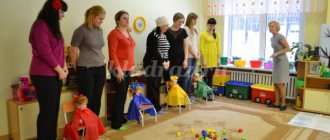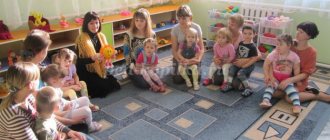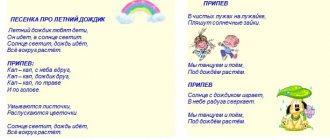MAGAZINE Preschooler.RF
Project in the first junior group “Magic cubes”Completed by: teacher Kornilova T.V. Municipal government educational institution kindergarten No. 9 “Solnyshko”, Chkalovsk 2020
Explanatory note:
Constructive activity is a practical activity aimed at obtaining a specific, pre-thought-out real product that corresponds to its functional purpose. design has extremely wide possibilities for mental, moral, aesthetic, and labor education.
Construction of various buildings from building materials for young children. During the construction process, children's sensory and thinking abilities are developed. Playing with building materials has an impact on the all-round development of the child. Children's construction is closely related to play: children's buildings are used for practical use and for play. In children aged 2–3 years, construction and play “nearby” .
A variety of building materials develops children's creative activity. Therefore, it is necessary to create the necessary conditions and select materials for the developing subject environment. You should consider placing a variety of building materials in the group room, placing it accessible so that it is convenient for children to play with it.
LEGO sets Builder set (cube, brick , cone, cylinder) are used. To play with buildings, you need toys that are commensurate with the buildings being created (cars, dogs, cats, nesting dolls, etc.).
Relevance:
The problem of developing interest in design in preschool children occupies a significant place in preschool pedagogy. Since a variety of constructive creativity gives children the opportunity not only to explore the world around them, but also to comprehensively develop their abilities.
The relevance of the problem of conducting design classes in preschool institutions is that at this stage of development of society, fewer hours are devoted to design for children to master than other disciplines (speech development, cognition, drawing, etc.)
Construction in the learning process is a means of deepening and expanding the acquired theoretical knowledge and developing the creative abilities, inventive interests and inclinations of students.
The purpose of the project: to develop the ability to carry out this or that construction, to know the names of buildings; develop the child’s thinking, intelligence and creativity, his moral qualities, aesthetic feelings.
Project objectives:
- Development of cognitive interest of preschool children in design.
- Formation of design skills and abilities, gaining first experience in solving design problems, getting to know designers.
- Development of creative activity, independence in making optimal decisions in various situations, development of attention, working memory, imagination, thinking.
- Development of fine motor skills and hand coordination in preschool children.
- Developing responsibility, discipline, and communication skills.
- Promote the formation of active speech.
The main form of training: directly organized educational activities.
Working methods and techniques:
- observation;
- sample display and analysis;
- explanation of the sequence and methods of construction;
- clarifications, questions;
- artistic word;
- gaming techniques;
- playing around with created buildings;
- analysis and evaluation of the work process.
Forms of organization:
- lesson in subgroups;
- individual work with a child;
- teamwork;
Project participants: children of the first junior group, teachers, parents.
Type of project: group.
Duration: 1 year
Expected results:
- The child shows initiative and independence in various types of activities - play, communication, construction; able to select participants for joint activities.
- The child has developed gross and fine motor skills; can control and control his movements.
- The child has developed a strong interest in design activities and a desire to experiment.
- The child masters the techniques of individual and joint design.
Plan
Stage 1 – preparatory.
Tasks:
- Study and selection of methodological literature on the topic of the project.
- Think over a system of activities with children of the first junior group to achieve the goals and objectives of the project.
- LEGO sets Builder sets (cube, brick , cone, cylinder, toys commensurate with the buildings being created (cars, dogs, cats, nesting dolls, etc.)
- stage – practical.
Tasks:
- Learn to name the parts of the LEGO construction set, continue to learn to name the parts of the “Builder” (brick, cube, cone, prism).
- Teach the simplest analysis of constructed buildings (identify the shape, size, color of details).
- Carry out the simplest design in accordance with the given conditions (bed for a doll).
- Compare objects by length and width.
- Enrich speech with phrases (the red track is long (wide).
- Design according to the sample and conditions.
- Distinguish by color and shape.
- Develop hand-eye coordination when connecting construction parts, achieve precision in the process of operational actions.
- stage – final.
Tasks:
- Observe whether the knowledge acquired by children during the project is reflected in independent activities.
- Summarize.
Literature:
- Arapova - Piskareva N. A. Formation of elementary mathematical concepts in kindergarten: program and method. recommendations. For classes with children 2 – 7 years old. – M.: Mosaika-Sintez, 2008.
- Gubanova N. F. Development of gaming activities. System of work in the first junior group of kindergarten. – M.: Mosaika-Sintez, 2008.
- Kutsakova L. V. Design and manual labor in kindergarten: program and method. recommendations. For classes with children 2 – 7 years old. – M.: Mozaika-Sintez, 2010.
- Lishtvan Z.V. Design. – M.: Education, 1991.
- Petrova V. A. Classes on speech development with children under three years old. – M.: Education, 1970.
- Chernova E.I., Timofeeva E.Yu. Finger steps: exercises for the development of fine motor skills. – St. Petersburg: Corona-century 2007.
Conclusions on the implementation of the project on design and modeling with children of early preschool age in the first junior group “Teremok”
Children transfer the knowledge and skills acquired in classes to independent activities.
In the first junior group, children play with parts that are familiar to them. It is very important that an adult takes direct part in children's games. To do this, I used such techniques as: reminding them of what we built earlier, how we played with buildings and toys, and inviting the children to repeat or change the building I made.
In the game, children improve, rebuild, and add various details to the same building over many days. When acting out the building, I suggested possible actions to the children or showed them how to do it. She made sure that the children handled the building material carefully and, at the end of the games, put it away in a permanent place.
It is necessary to notice successful buildings that a child has created by chance, to attract the attention of other children to them, and to praise the child for his independence and activity.
When children play with building materials, it is necessary to maintain good relationships between the kids: teach them not to disturb each other, share toys, and respond to a peer’s request.
As a result of the project, the child can:
know
- basic building parts (cubes, bricks , bridges, etc.);
- basic design techniques;
- primary colors.
be able to
- change buildings in two ways: by replacing some parts with others or building them up in height and length;
- connect LEGO pieces,
- play around with buildings.
have an idea
- about the simplest analysis of created buildings;
- about options for creating structures when adding other parts.
| Next > |
Features of the organization of constructive-model activities of preschool children
MDOU IRMO "Mamonovsky combined kindergarten"
Topic:
“Features of organizing constructive-model activities of preschool children”
The Federal State Educational Standard for Preschool Education sets new guidelines for the development of the preschool education system and makes a number of changes to the organization of educational activities in preschool educational institutions.
“A child’s games with toys—the materials from which he constructs—are closest to normal human activity: from materials a person creates values and culture”
A.S.
Makarenko The term “design”
(from the Latin word construere) means bringing various objects, parts, elements into a certain relative position.
Under children's design
it is customary to mean the creation of different designs and models from different types of construction sets, the production of crafts from paper, cardboard, natural and waste materials
In accordance with the Federal State Educational Standard for Educational Education, “constructive-model” activities belong to the educational field “Artistic and Aesthetic Development”.
Design is a productive activity because it is aimed at obtaining a specific product.
The main purpose of the design:
Development of children's artistic creativity, interest in independent creative activity;
satisfying children's need for self-expression through construction from different materials. There are two types of design: technical and artistic. Technical
ones include:
- construction from building material (the parts of which have geometric shapes);
- constructing constructors from parts that have different fastening methods;
- construction from large-sized modular blocks.
In artistic
design include
- paper design
- construction from natural and waste materials.
There are many types
constructors: “Lego”, wooden, plastic, metal, magnetic, etc.
Nowadays, many different construction sets have been created for children, having a variety of shapes and types of fastening. A child can choose any one for his creativity.
But we must not forget about safety rules!
Construction sets containing small parts can only be given to the middle group under adult supervision (such as magnetic ones and various types of mosaics)!!!!
Artistic design: paper
- By combining different paper forms a huge variety of crafts are created.
- Despite its attractiveness, it complex activity
.. Therefore, the traditional method is based on a visual and detailed step-by-step explanation.
When designing from paper, you can use paper of different textures (depending on the tasks at hand).
Children learn:
- make markup using a template;
- create fun toys.
- and three-dimensional toys made using the origami technique.
Here you see crafts made using different techniques.
Made from natural material
- Natural material can be used as a building material for children's games, starting from the second junior group
. This is primarily sand, snow, water. From raw sand, children build a road, a house, using molds (sandboxes) - pies, Easter cakes
- In more older age
children freeze colored water, preparing colored ice flakes with which to decorate the area.
- The variety of natural materials (cones, acorns, branches, seeds, grass, etc.) and ease of processing allow it to be widely used in working with preschoolers
Beginning teachers can now take samples of crafts not only from manuals, but also from Internet resources.
Artistic design
from waste material
- You can use materials whose main requirement is safety: boxes of perfume, powder, matches, pieces of wire in colored winding, polystyrene foam, foam rubber, corks, etc. In fact, they are semi-finished products.
By connecting them with plasticine, glue or wire and adding various parts, you can get interesting toys - furniture, vehicles and other products.
Design forms:
Let us briefly consider all the forms of organization of teaching children's design known to us .
Design based on a model
is that children are offered samples of buildings made from parts of building materials and construction sets, paper crafts, etc. and, as a rule, show ways to reproduce them.
You can offer children types of work based on the model
:
- Independent design according to drawing
- Didactic game “Assemble a model from memory”
Design using simple drawings and visual diagrams
. Teaching children first to construct simple diagrams-drawings reflecting examples of buildings, and then, conversely, to practically create structures using simple diagrams-schemes.
Design by model
– Children are presented with a model as a model, in which the outline of its individual elements is hidden from the child. Children must reproduce this model from the building material they have. Thus, in this case, the child is offered a certain task, but is not given a way to solve it.
Design according to conditions
- fundamentally different in nature. It is as follows. Without giving children a sample of the building, drawings and methods of its construction, they only determine the conditions that the building must meet (for example, a house for a dog should be small, and for a horse – large).
Design
by design
is the independent creation of an image of a future structure and its embodiment in the material that the child has at his disposal.
Here we see plot construction by design, independent and collective (which can be performed by 2 or more people)
Constructive-model development in age groups
In the first younger group, the simplest construction .
By the age of three, children can already name what they will build. They learn to distinguish materials by shape and size, correctly name objects of building material (cube, brick), understand and correctly use words (big - small, high - low); follow verbal instructions. In games you should use figurative expressions, literary words, songs
Second junior group
. A more sustainable desire for independence appears. The main material for construction is construction material. Its sets are replenished with a new part - a bar. Children get acquainted with it, and it becomes clear how it differs from other parts (cube, brick, plate), in which position it is most stable: The teacher gradually complicates the task. Changing buildings in two ways: replacing some parts with others or building them up in height and length (low and high tower, short and long train).
The first buildings of their own design appear.
Middle group
. Four-year-old children acquire a fairly stable interest in construction games. The construction of crafts from paper, natural and waste materials appears.
In the older group
the ability to create buildings of different sizes and designs of the same object is formed.
We teach you how to build according to a drawing and how to independently select the necessary building materials.
We continue to develop the ability to work collectively, combine our crafts in accordance with a common plan, and agree on who will do what part of the work.
In the preparatory group
We teach you how to create structures united by a common theme (children’s playground, parking lot, etc.).
Create various models (buildings, planes, trains, etc.) according to a drawing, according to the teacher’s verbal instructions, according to one’s own ideas.
In accordance with the Program, it is at this age that children become familiar with a variety of plastic construction sets, as well as a wooden construction set, the parts of which are attached with pins. In fact, unfortunately, there are no such wooden construction sets in kindergartens yet!
Creation of three-dimensional toys using the origami technique,
Made from natural and waste materials.
Games contribute to the development of initial design skills:
Game "3 dice"
Each building has three parts.
Exercise:
according to the drawing, which shows the front view, create the given building. This game teaches you how to create the first buildings according to the scheme.
In the game “Match by Shape”
we train children in the ability to recognize and name three-dimensional shapes; relate geometric shapes to objects in the surrounding world.
Subject of design,
Just like planning of other types of activities, it should be determined in accordance with thematic calendar planning:
- During the thematic block “Vegetables and Fruits” you can plan the construction of a “Cellar for storing vegetables”
- block “Animals” - an enclosure for animals.
- Block My Homeland - Nerpinaria, etc.
We must remember that children really like to make something unusual. Children always perceive an unconventional approach to design with great interest.
But there are also problems:
- Insufficient equipment (there are no wooden construction sets with connections with fonts, soft modules are not available everywhere)
- It is necessary to conduct training seminars for teachers on design in preschool organizations in order to expand and deepen their knowledge on this topic.
- During design classes, development of sensory and thinking abilities
children.
- Construction has a great influence on the development of the child’s personality and volitional sphere.
- Implemented physical improvement
child.
- It's effective a means of aesthetic education.
Children develop artistic taste.
- Constructive activity is also a means moral education
preschoolers. In the process of this activity, important personality qualities are formed: hard work, independence, initiative, perseverance in achieving goals, organization.
I wish you creativity in your approach to developing children's design abilities!!!


